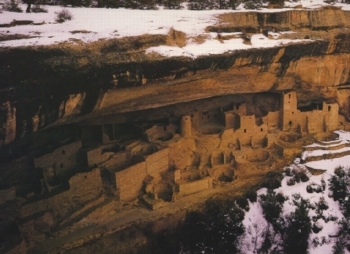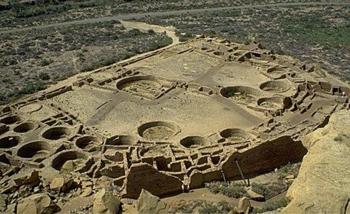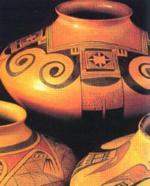
One of the major urban societies of North America, flourished 1050 - 1300.

A section of the "cliff palace", an Anasazi town in Colorado, USA.
The Anasazi live in the area where the borders of today's Arizona, New Mexico, Colorado and Utah meet. They were probably the original inhabitants of the area; their name means "the ancient ones" in Navajo. From 100 AD onward they developed a distinctive culture known for its basket-weaving skills. They led a semi-nomadic life but already cultivated maize and pumpkins. By about 500 AD they were mainly occupied with agriculture; they had domesticated turkeys and established village settlements in caves or by using basic shelters.
The Anasazi civilization can be said to have begun around 700 when the Anasazi villages began to expand into larger crescent-shaped houses built of stone and often including both a below-ground and above-ground level. The transition to a sedentary lifestyle led to the replacement of the storage baskets by pots, which soon became very artistic in their decorations.
The high period of Anasazi civilization occurred around 1050 - 1300. The houses increased in size and quality. Many consisted of two, three or four storeys and offered apartment-style living, with 20 to as many as 1,000 rooms in a single building. Often these houses were built under overhanging cliffs. Pottery continued to flourish, and weaving of cotton and yucca fibre was craftfully mastered.
A mayor centre of the Anazasi civilization was located in the Chaco Canyon in today's New Mexico. There is much evidence to suggest that the settlements found in the canyon were not permanent cities but part of a religious complex that was visited on particular occasions:
The houses in Chaco Canyon were of very different size and must have served different purposes. Small houses have markings in their walls that allowed the observation of the sun's approach to its solstice position. Larger houses had several hundred rooms on up to eight floors and were obviously accommodation for many people. All were built of stone, some with decorative stone arrangements. Art work has also been discovered.
Why the large cliff and other community houses were abandoned during the 13th century is not clear. Navajo and Apache incursions may have played a role, and a prolongued drought between 1276 and 1299 might also have led to a change of settlement locations. New villages were built to the east and south of the original area. They were larger than the cliff villages but the building quality of the houses declined.
Today's descendants of the Anasazi are known as Pueblo, the name given to them (and to other indigenous Americans) by the Spanish because of the large villages that characterized their society. ("Pueblo" is Spanish for "village" or "town.") They still live in the area of their ancestors in villages of apartment-style houses and continue their tradition of fine pottery. The number of Anasazi villages, which had reached 70 - 80 during the high period of their civilization, is now 25 - 30.

Pueblo Bonito, one of the buildings in the Chaco Canyon, built in stages beginning 919. The settlement contained about 800 rooms on five floors. During its later stage some of the ground floor rooms were filled with rubble to support the upper floors. The round structures are kivas (religious assembly rooms).

Modern Pueblo pottery